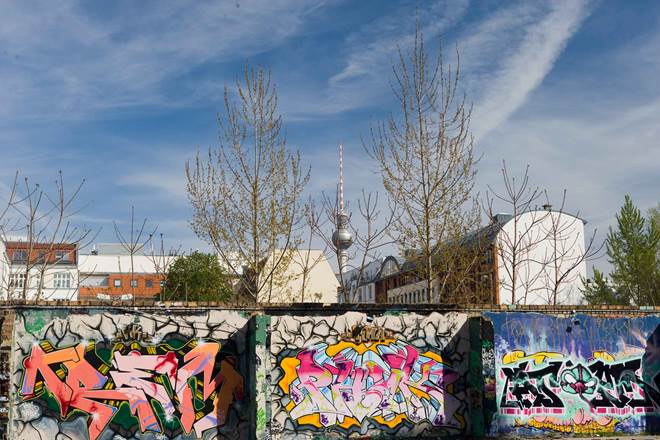It’s been over three decades since the Berlin Wall came down, and Germany unified, but East Berlin still has its own character and atmosphere distinct from the city’s western half.
Although it has been a long time since its days as the capital of the German Democratic Republic (GDR), remnants of the communist era and Cold War intrigue still dot the area. But it’s also home to a vibrant arts and culture scene. In fact, much of Mitte, Berlin’s central district filled with museums, monuments, and government buildings, was once behind the Berlin Wall.
For history lovers or fans of spy movies, East Berlin is an essential stop on any trip to Germany, and train travelers will find themselves right on its doorstep if they are entering the city from Berlin Central Station.
Image Credit: Getty Images, Clement LEONARD. Image Location: Berlin, Germany
Start at Checkpoint Charlie
It’s as good a place as any to start a trip beyond the Iron Curtain. Checkpoint Charlie is an iconic piece of the city and one of the last still-standing remnants of the Berlin Wall.
Though it is now in the middle of a street with little distinction from one side to the other, the checkpoint used to be one of the few places where crossing between east and west could happen. Today, it still bears its famous sign warning passers-by that they are “leaving the American Sector.”
Next to the checkpoint itself is the Checkpoint Charlie Museum, which includes a memorial to those who died trying to make it over the wall and documents the impact dividing Berlin had on the city.
Image Credit and Location: DDR Museum, Berlin, Germany
Immerse yourself at the DDR Museum
Moving further east is the DDR Museum. The interactive museum, located along the banks of the Spree River, provides an immersive journey into the heart of East Germany's socialist past, and offers a glimpse into daily life in the GDR during the Cold War era.
Here you can explore a reconstructed East German apartment, sit in a Trabant car, and even experience the surveillance methods of the Stasi secret police.
Karl-Marx-Allee: a Socialist monument
The historic boulevard stands as a testament to the power of the Eastern Bloc. Originally named Stalinallee, it was designed to showcase socialist ideals through monumental architecture.
Lined with grandiose neoclassical buildings with decorative facades, it is far from the image of brutalist architecture that has come to define Europe’s former socialist states. Even in socialist times, it was lined with shops and cafés and still has a lively, urban atmosphere as one of the united city’s main thoroughfares.
See the Berlin Wall at East Side Gallery
This open-air gallery stretches along a 1.3-mi preserved section of the Berlin Wall and is adorned with over 100 vibrant murals and street art creations.
Far from the symbol of division the wall once was, the artwork of today’s East Side Gallery conveys diverse messages of hope, freedom, and unity, reflecting the dramatic changes in Berlin and the world after the fall of the Wall in 1989.
Among the most notable pieces are the Fraternal Kiss and Test the Rest, which capture the spirit of Berlin’s reunification era.
Visit the old Stasi HQ
What the Gestapo were to Nazi Germany and the KGB to the Soviet Union, the Stasi were for Communist East Germany. Housed in the former Stasi headquarters, the museum provides a sobering look at the extensive surveillance and oppression carried out by the Stasi during the GDR era.
Visitors can explore the actual offices, interrogation rooms, and surveillance equipment used by the secret police force, while the museum’s exhibits and personal stories of those who suffered under Stasi control offer a haunting insight into the lengths to which authoritarian regimes can go to maintain control over their citizens.
Image Credit: Getty Images, bluejayphoto. Image Location: Kreuzberg, Berlin, Germany
The coolest areas in Berlin
Friedrichshain
Friedrichshain is often considered one of the coolest neighborhoods in Berlin due to its unique blend of history, culture, and a vibrant, creative atmosphere. It's home to some of Berlin's most iconic clubs, such as Berghain, which is globally famous for its techno and hard-to-get-into-door policy.
Kreuzberg
After the sobering experience of revisiting the Cold War era through your tour of Berlin’s east side, you’ll probably want a drink. Arguably, there’s no better place in Berlin – east or west – than Kreuzberg, one of the city’s hippest neighborhoods. It’s a hub for artists, musicians, and young creatives, and offers a unique blend of Turkish markets, trendy bars, street art, and a rich culinary scene.
Download the Trainline app and dive into Berlin's art and cultural scene. Find hidden treasures in Berlin's flea markets or venture out of the city for a day trip to one of the many wonders of Germany.
Header Image: Getty Images, Image Source. Image Location: Berlin, Germany

